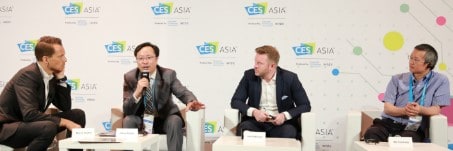Events

Deloitte Explored the Future of Mobility at CES Asia 2017
7 June 2017, Shanghai
China market exhibits a number of distinct traits that are quite different from mature markets, such as the customer psychographics, the population density in the mega cities, the convenient high speed rail system, and the government influencing power. How would those traits interact with the global trends to reshape China's mobility system? The players in the extended automotive ecosystem are keen to find out the answer.
Deloitte was invited to join 2017 CES Asia and produced a half-day discussion on June 7th, which convened panellists and keynote presenters representing automakers, technology companies, policy makers, researchers, and others working in the mobility ecosystem to dive into this subject from various aspects.
Followed are the key takeaways of Deloitte panels and a list of relevant publications on each topic. We hope you find these insights valuable.
Exploring the Future of Mobility
Moderator: Deloitte China Automotive Leader, Mr. Marco Hecker
Panelists:
- NIO Co-founder & EVP, XPT CEO, Mr. Jack Cheng
- GAC Automotive Engineering Institute, Vice President, Mr. Zha Hong Shan
- NEVS, Director Product Innovation, Ms. Anna Haupt
Download the Keynote speech presentation
Key Takeaways:
The people born after 1990 is considered the generation of the Internet, whose life and the Internet are inseparable. They value more on convenience, efficiency, and connectivity when it comes to commute from point A to B. To fulfil their various needs in mobility, it is expected to see more cross sectors collaboration in the future of mobility eco-system to solve consumer's safety concern on automated driving and facilitate the prevalence of ride-sharing and autonomous driving. In the next five to ten years, Level 4* automated driving may be seen on some of the highways in China. In certain pilot zones or industrial parks, we may see the Level 5*, fully autonomous driving on the road.
*A classification system based on six different levels (ranging from none to fully automated systems) was published in 2014 by SAE International, an automotive standardization body, as J3016, Taxonomy and Definitions for Terms Related to On-Road Motor Vehicle Automated Driving Systems.
Relevant publications
The future of mobility: What’s next? Tomorrow’s mobility ecosystem—and how to succeed in it
Supplying the future of mobility: Automotive suppliers in the evolving transportation ecosystem
Framing the future of mobility: Using behavioural economics to accelerate consumer adoption
Smart Cities and Smart Mobility
Panel moderator: Deloitte Global Consumer & Industrial Products Leader, Tim Hanley
Panelists:
- Horizon Robotics Inc., Founder & CEO, Mr. Yu Kai
- Zhuhai Da Heng Qin Technology Development Co., CEO, Mr. Deng Lian Bing
- Deloitte China Smart City Leader, Ms. Clare Ma
Download the Keynote speech presentation
Key Takeaways:
In recent years, the focus of smart city developments in China are quite different comparing to other countries. The emphases are in the following areas: 1.digitalized city management system (using digital system to manage the city assets); 2.smart security and order (referring to anti-terrorism, environment monitoring, and the food safety); 3.smart sharing of city public resources (smart medical, education, travel, sports, and community); 4.public services enhancement in quality and efficiency (referring to smart public administrative system). However, with the traffic congestion and air pollution continue to worsen in the cities, a number of city authorities begin to invest more resources on smart mobility. The best illustration is the emergence of small towns or science parks featuring smart city and smart mobility. In those pilot zones, the authorities strongly encourage the ride sharing as well as increase the number of electric charging stations. It is worth to mention that when planning and implementing smart city and smart mobility initiative, the authority can't only think of hardware and software infrastructure. The consideration need to go back to the need of the G2G/G2B/G2C target audience. Then, re-evaluate smart city strategy, break the existing functional borders, and come out with the best solutions and systematically implementing them.
Relevant publications
Making cities smarter: How citizens' collective intelligence can guide better decision making
Exploring Consumers’ Shifting Mobility Decisions
Panel moderator: Deloitte China Automotive Leader, Mr. Marco Hecker
Panelists:
- Audi Sales Division, Head of CRM, Mr. Gong Xingbo
- BMW Automotive China, Head of Mobility Services, Mr. Joe Pattinson
- Banma Technologies, CEO, Mr. Shi Xue Song
Key Takeaways:
Understanding consumer's mobility need has become the top priority of many auto OEMs and brands. The concept of mobility for the players in the ecosystem has evolved from getting the consumer from point A to B to analyzing the purpose of their journey and the need while they are on the road. Through the applications of IoT and data analytics, a few players have come out with the services that can provide the best mobility solutions based on the customer's purpose and preference, aiming to create a more convenient and efficient mobility experience for the customer. While there are various mobility solutions in the market, such as DiDi and Mobike, it does not conflict with personal car ownership. Most of Chinese consumers still desire to own a car. The variety of new mobility solutions simply supplement the consumer's mobility need, offering more options for the consumers to choose in difference occasions.
Relevant publications
2017 Deloitte Global Automotive Consumer Study: What's ahead for fully autonomous driving
The future of auto retailing: Preparing for the evolving mobility ecosystem
The new digital divide: The future of digital influence in retail
Recommendations
The Future of Mobility
How transportation technology and social trends are creating a new business ecosystem




